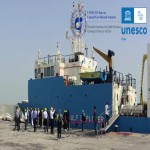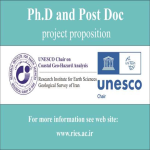
Coccidioides fungus at the center of tissue sample from a person with Valley fever. | National Institutes of Health
There was an unusual “side effect” of the 1994 Northridge earthquake: a major outbreak of Valley fever in Ventura County, California.
Valley fever is a respiratory disease, endemic to the United States’ Southwest and parts of Central and South America. It is caused by Coccidioides fungus, which grows in the upper few inches of soil. People develop Valley fever after inhaling dust containing the fungal spores. Although 60% of people who inhale Coccidioides are asymptomatic, the fungus can cause a flu-like illness and very rarely can spread outside the lungs to other organs.
In the eight weeks after the Northridge earthquake, there were 203 cases of Valley fever reported in Ventura County—an order of magnitude more than the expected number of cases for that region and that time of year. Three people died from Valley fever, representing 4% of Northridge-related deaths.
So how were the earthquake and outbreak connected? U.S. Geological Survey seismologists Edwin Harp and Randall Jibson partnered with scientists from the U.S. Centers for Disease Control and Prevention to solve the medical mystery. Their initial suspect and eventual culprit: landslides. The earthquake triggered more than 10,000 landslides in the area, with a large concentration of them in the young, weakly consolidated material in the steep-walled canyons of the Santa Susana Mountains. The researchers found that the outbreak fit a temporal and spatial pattern of landslide dust blown southwest from the mountains into Simi Valley. The dust was visible from aerial reconnaissance flights, and Simi Valley drivers reported using their headlights right after the earthquake to see through the thick plumes.
Read more about this month’s historic earthquake in key papers from SSA journals. The following papers will be available for free for two weeks, from 17-Jan-2023 to 31-Jan-2023.

A.F. Shakal et al. (1996)
Source Complexity of the 1994 Northridge Earthquake and Its Relation to Aftershock Mechanisms
H.K. Thio; H. Kanamori (1996)
A Composite Source Model of the 1994 Northridge Earthquake Using Genetic Algorithms
Y. Zeng; J.G. Anderson (1996)
Variability in Nonlinear Sediment Response During the 1994 Northridge, California, Earthquake
S. Hartzell (1998)
W.J. Stephenson et al. (2000)
J. Boatwright et al. (2001)
A Model of Tectonic Stress State and Rate Using the 1994 Northridge Earthquake Sequence
S. Gross (2001)
D.M. Boore et al. (2003)
Northridge Earthquake Effects on Pipelines and Residential Buildings
S-S Jeon; T.D. O’Rourke (2005)

A Report on Geotechnical Aspects of the January 17, 1994 Northridge Earthquake
J.P. Stewart et al. (1995)
P.G. Somerville (1997)
T. Heaton (2014)
You are receiving this email because you subscribed to The Seismic History, a newsletter shared with members of the Seismological Society of America.
Update your mailing preferences: Unsubscribe
Seismological Society of America
Albany, California 94706-1375
United States
Tel: 510-525-5474















